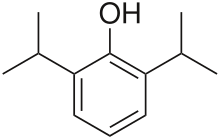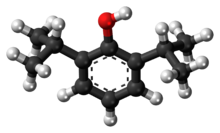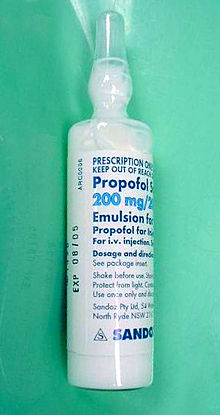Propofol
 | |
 | |
| Clinical data | |
|---|---|
| Trade names | Diprivan, others[1] |
| AHFS/Drugs.com | Monograph |
| License data | |
| Pregnancy category |
|
seizures) Psychological: no data | |
| Addiction liability | Moderate[2] |
| Routes of administration | Intravenous |
| ATC code | |
| Legal status | |
| Legal status | |
| Pharmacokinetic data | |
| Bioavailability | NA |
| Protein binding | 95–99% |
| Metabolism | Liver glucuronidation |
| Onset of action | 15–30 seconds[5] |
| Elimination half-life | 1.5–31 hours[5] |
| Duration of action | ~5–10 minutes[5] |
| Excretion | Liver |
| Identifiers | |
| |
kcal/mol[6] | |
| |
| |
| (verify) | |
Propofol
Recovery from propofol-induced anesthesia is generally rapid and associated with less frequent side effects, or some combination of the two.
First synthesized in 1973, by
Uses
Anesthesia
Since its introduction, propofol has become almost exclusively the drug of choice of anesthesiologists for the induction and maintenance of
It is often administered as part of an anesthesia maintenance technique called
Propofol is also used to sedate individuals who are receiving mechanical ventilation but not undergoing surgery, such as patients in the intensive care unit.[14] In critically ill patients, propofol is superior to lorazepam both in effectiveness and overall cost.[15] Propofol is relatively inexpensive compared to medications of similar use due to shorter ICU stay length.[15] One of the reasons propofol is thought to be more effective (although it has a longer half-life than lorazepam) is that studies have found that benzodiazepines like midazolam and lorazepam tend to accumulate in critically ill patients, prolonging sedation.[15]
Propofol has also been suggested as a
Propofol can be administered via a peripheral IV or central line. Propofol is often paired with fentanyl (for pain relief) in intubated and sedated people.[16] The two drugs are molecularly compatible in an IV mixture form.[16]
Propofol is also used for deepening of anesthesia in order to relieve
Routine procedural sedation
Propofol is safe and effective for gastrointestinal endoscopy procedures (colonoscopies etc.). Its use in these settings results in a faster recovery compared to
COVID-19
In March 2021, the U.S.
Status epilepticus
Status epilepticus may be defined as seizure activity lasting beyond five minutes needing anticonvulsant medication. Several guidelines recommend the use of propofol for the treatment of refractory status epilepticus.[28]
Other uses
Assisted death in Canada
A lethal dose of propofol is used for medical assistance in dying in Canada to quickly induce deep coma and death, but rocuronium is always given as a paralytic ensuring death, even when the patient has died as a result of initial propofol overdose. [29]
Capital punishment
Use of propofol as part of an execution protocol has been considered, although no individual has been executed using this agent. This is largely due to European manufacturers and governments banning the exportation of this propofol for such use.[30][31]
Recreational use
Recreational use of the drug via self-administration has been reported
Recreational use of the drug has been described among medical staff, such as
Attention to the risks of off-label use of propofol increased in August 2009 due to the Los Angeles County coroner's conclusion that musician Michael Jackson died from a mixture of propofol and the benzodiazepine drugs lorazepam, midazolam, and diazepam on 25 June 2009.[42][43][44][45] According to a 22 July 2009 search warrant affidavit unsealed by the district court of Harris County, Texas, Jackson's physician, Conrad Murray, administered 25 milligrams of propofol diluted with lidocaine shortly before Jackson's death.[43][44][46]
Manufacturing
Propofol as a commercial sterile emulsified formulation is considered difficult to manufacture.[47][48][49]
It was initially formulated in
Side effects
One of propofol's most common side effects is pain on injection, especially in smaller veins. This pain arises from activation of the pain receptor, TRPA1,[54] found on sensory nerves and can be mitigated by pretreatment with lidocaine.[55] Less pain is experienced when infused at a slower rate in a large vein (antecubital fossa). Patients show considerable variability in their response to propofol, at times showing profound sedation with small doses.
Additional side effects include
Propofol can also cause decreased
Although propofol is widely used in the adult ICU setting, the side effects associated with medication seem to be more concerning in children. In the 1990s, multiple reported deaths of children in ICUs associated with propofol sedation prompted the FDA to issue a warning.[61]
As a respiratory depressant, propofol frequently produces apnea. The persistence of apnea can depend on factors such as premedication, dose administered, and rate of administration, and may sometimes persist for longer than 60 seconds.
Propofol administration also results in decreased cerebral blood flow, cerebral metabolic oxygen consumption, and intracranial pressure.[63] In addition, propofol may decrease intraocular pressure by as much as 50% in patients with normal intraocular pressure.[64]
A more serious but rare side effect is
Propofol is also reported to induce priapism in some individuals,[66][67] and has been observed to suppress REM sleep stage and to worsen the poor sleep quality in some patients.[68]
Rare side effects include:[69]
- anxiety
- changes in vision
- cloudy urine
- coughing up blood
- delirium or hallucinations
- difficult urination
- difficulty swallowing
- dry eyes, mouth, nose, or throat
As with any other general anesthetic agent, propofol should be administered only where appropriately trained staff and facilities for monitoring are available, as well as proper airway management, a supply of supplemental oxygen, artificial ventilation, and cardiovascular resuscitation.[70]
Because of propofol's formulation (using lecithin and soybean oil) it is prone to bacterial contamination, despite the presence of the bacterial inhibitor benzyl alcohol, consequently - some hospital facilities require the IV tubing (of continuous propofol infusions) to be changed after 12 hours. This is a preventive measure against microbial growth and potential infection.[71]
Propofol infusion syndrome
A rare, but serious, side effect is propofol infusion syndrome. This potentially lethal metabolic derangement has been reported in critically ill patients after a prolonged infusion of high-dose propofol, sometimes in combination with catecholamines and/or corticosteroids.[72]
Interactions
The respiratory effects of propofol are increased if given with other respiratory depressants, including benzodiazepines.[73]
Pharmacology
Pharmacodynamics
Propofol has been proposed to have several mechanisms of action,
Propofol is an inhibitor of the enzyme
Pharmacokinetics

Propofol is highly protein-bound in vivo and is metabolized by
History
John B. Glen, a veterinarian and researcher at Imperial Chemical Industries (ICI), spent thirteen years developing propofol, an effort for which he was awarded the 2018 Lasker Award for clinical research.
Originally developed as ICI 35868, propofol was chosen after extensive evaluation and
First identified as a drug candidate in 1973, propofol entered clinical trials in 1977, using a form solubilized in
Developments
A water-soluble prodrug form, fospropofol, has been developed and tested with positive results. Fospropofol is rapidly broken down by the enzyme alkaline phosphatase to form propofol. Marketed as Lusedra, this formulation may not produce the pain at injection site that often occurs with the conventional form of the drug. The U.S. Food and Drug Administration (FDA) approved the product in 2008.[90]
By incorporation of an
Ciprofol is another derivative of propofol that is 4–6 times more potent than propofol. As of 2022[update] it is undergoing Phase III trials. Ciprofol appears to have a lower incidence of injection site pain and respiratory depression than propofol.[94]
Propofol has also been studied for
References
- ^ "Propofol". Drugs.com. Retrieved 2 January 2019.
- S2CID 19157711.
Propofol is a general anesthetic, however its abuse for recreational purpose has been documented (120). Using control drugs implicated in both ΔFosB induction and addiction (ethanol and nicotine), similar ΔFosB expression was apparent when propofol was given to rats. Moreover, this cascade was shown to act via the dopamine D1 receptor in the NAc, suggesting that propofol has abuse potential (119)
- ^ Anvisa (31 March 2023). "RDC Nº 784 - Listas de Substâncias Entorpecentes, Psicotrópicas, Precursoras e Outras sob Controle Especial" [Collegiate Board Resolution No. 784 - Lists of Narcotic, Psychotropic, Precursor, and Other Substances under Special Control] (in Brazilian Portuguese). Diário Oficial da União (published 4 April 2023). Archived from the original on 3 August 2023. Retrieved 16 August 2023.
- ^ "Diprivan- propofol injection, emulsion". DailyMed. Retrieved 17 April 2021.
- ^ a b c d "Propofol". The American Society of Health-System Pharmacists. Archived from the original on 9 October 2016. Retrieved 21 January 2017.
- PMID 25303275.
- ^ "Propofol". PubChem. U.S. National Library of Medicine. Retrieved 25 October 2023.
- ^ "Making Stable, Sterile Propofol". www.microfluidics-mpt.com. Retrieved 25 October 2023.
- ^ "Propofol". go.drugbank.com. Retrieved 25 October 2023.
- S2CID 115198733.
- hdl:10665/345533. WHO/MHP/HPS/EML/2021.02.
- ^ "Propofol - an overview | ScienceDirect Topics". www.sciencedirect.com. Retrieved 25 October 2023.
- S2CID 27253877.
- ^ PMID 29308828.
- ^ PMID 18176312.
- ^ PMID 8695138.
- .
- PMID 18440381.
- ^ Canadian National Formulary 2010
- ISBN 978-0-8385-0371-3.
- ^ Numorphan® (oxymorphone) package insert (English), Endo 2009
- PMID 18534971.
- PMID 26292077.
- ^ "Propofol-Lipuro 1% (propofol) Injectable emulsion for infusion – 1,000 mg in 100 ml (10 mg /ml) : Fact Sheet for health Care Providers" (PDF). Bbraunusa.com. Archived from the original (PDF) on 14 May 2021. Retrieved 5 March 2022.
- ^ "Letter RE: Emergency Use Authorization 096". Fda.gov. Retrieved 5 March 2022.
- ^ "Fact Sheet for Health Care Providers: Emergency Use Authorization (EUA) of Propofol-Lipuro 1% Injectable Emulsion for Infusion". Fda.gov. Retrieved 5 March 2022.
- ^ a b c "Emergency Use Authorization". U.S. Food and Drug Administration (FDA). Retrieved 17 April 2021.
- ISBN 978-1-264-26851-1.
- ^ Reggler J, Daws T (May 2017). "Medical Assistance in Dying (MAiD): Protocols and Procedures Handbook" (PDF). Divisions of Family Practice (2nd ed.). Comox Valley, British Columbia.
- PMID 32014115.
- ^ "Lethal injection: Secretive US states resort to untested drugs". BBC News. 15 November 2013. Retrieved 8 November 2023.
- S2CID 22531823.
- ^ Belluck P (6 August 2009). "With High-Profile Death, Focus on High-Risk Drug". The New York Times. Archived from the original on 11 November 2011. Retrieved 7 August 2009.
- S2CID 25963187.
- PMID 16431058.
- ISBN 978-0-85369-550-9.
- ISBN 978-0-444-50093-9.
- ^ S2CID 22477291.
- ^ Ward CF (2008). "Propofol: dancing with a "White Rabbit."" (PDF). California Society Anesthesiology Bulletin. 57 (Spring): 61–63. Archived from the original (PDF) on 8 September 2017. Retrieved 24 November 2014.
- S2CID 9877560.
- S2CID 15779389.
- ^ Moore S (28 August 2009). "Jackson's Death Ruled a Homicide". The New York Times. Archived from the original on 14 November 2013.
- ^ a b Surdin A (25 August 2009). "Coroner Attributes Michael Jackson's Death to Propofol". The Washington Post. Archived from the original on 9 November 2012. Retrieved 22 May 2010.
- ^ a b Itzkoff D (24 August 2009). "Coroner's Findings in Jackson Death Revealed". The New York Times. Archived from the original on 11 June 2010. Retrieved 22 May 2010.
- ^ "Jackson's Death: How Dangerous Is Propofol?". Time. 25 August 2009. Archived from the original on 25 July 2010. Retrieved 22 May 2010.
- ^ "Michael Jackson search warrant". Scribd. Archived from the original on 5 March 2016. Retrieved 12 August 2015.
- PMID 37061210.
- PMID 27192163.
- ^ WO 2014033751A2, Pramanick S, Gurjar S, Mehta SS, "Pharmaceutical composition of propofol", issued 2014-03-06, assigned to Emcure Pharmaceuticals Limited
- S2CID 115198733.
- ^ "Hospira recalls lot of Propofol Injectable Emulsion". European Pharmaceutical Review. Retrieved 8 November 2023.
- ^ "Understanding Emulsion Formulation | Ascendia Pharmaceuticals". ascendiapharma.com. Retrieved 8 November 2023.
- ^ "Stability of Emulsion - an overview | ScienceDirect Topics". www.sciencedirect.com. Retrieved 9 November 2023.
- PMID 18574153.
- ^ "Propofol Drug Information, Professional". m drugs.com. Archived from the original on 23 January 2007. Retrieved 2 January 2007.
- ^ S2CID 34331379.
- S2CID 31288656.
- S2CID 28545161.
- S2CID 43010280.
- PMID 24024005.
- PMID 1393073.
- PMID 3292208.
- S2CID 26019589.
- S2CID 46973781.
- PMID 11973196.
- S2CID 36563320.
- PMID 19371930.
- S2CID 21206446.
- ^ "Propofol (Intravenous Route) Side Effects - Mayo Clinic". Mayoclinic.org. Retrieved 24 January 2022.
- ^ "AstraZeneca – United States Home Page" (PDF). .astrazeneca-us.com. Archived from the original (PDF) on 4 October 2011. Retrieved 8 June 2013.
- PMID 28822211.
- S2CID 23932736.
- ^ Doheny K, Chang L, Vila Jr H (24 August 2009). "Propofol Linked to Michael Jackson's Death". WebMD. Archived from the original on 28 August 2009. Retrieved 26 August 2009.
- PMID 10637364.
- PMID 18482023.
- PMID 18175094.
- PMID 9599235.
- PMID 11259561.
- PMID 12109905.
- S2CID 25072723.
- PMID 18574460.
- PMID 15106622.
- ^ S2CID 27303365. Retrieved 11 December 2022.
- S2CID 14699319.
- PMID 12839875.
- PMID 12067002.
- S2CID 30185553.
- PMID 7452689.
- ^ Lasker Foundation. "Discovery and development of propofol, a widely used anesthetic". The Lasker Foundation. Retrieved 25 July 2020.
- ^ "Drugs@FDA: FDA Approved Drug Products". U.S. Food and Drug Administration (FDA). Archived from the original on 13 August 2014. Retrieved 8 June 2013.
- PMID 22968919.
- PMID 24056400.
- PMID 8391811.
- PMID 35922771.
- S2CID 261479363.
External links
- "Propofol". Drug Information Portal. U.S. National Library of Medicine.
- GB patent 1472793, John B Glen & Roger James, "Pharmaceutical Compositions", published 1977-05-04, assigned to Imperial Chemical Industries Ltd
